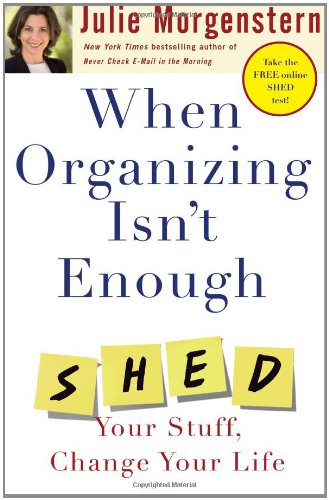We found a lot of inspiration a few years ago when we read “Organizing from the inside out” by Julie Morgenstern.
We also watched a video and we really enjoyed her approach. She is one of our favorite organizers!!.
I just read one of her more recent books “When Organizing Isn’t Enough. SHED Your Stuff, Change Your Life”.
I have been a professional organizer since 2012 and I found a LOT of value reading this book. If you are interested in organizing and simplifying your life I encourage you to read it.
I would like to share some notes from the book along with some personal comments from my experience.
When Organizing Isn’t Enough
Shed Your Stuff, Change Your Life.
” When you are eager to make a change in your life, but you are unsure of your new destination, you need to SHED. SHED picks up where other organizing processes leave off helping you purge the physical and behavioral clutter holding you back so you can finally create real change in your life”
Julie writes about how important is to plan for positively managing change in every aspect of your life. Changes that really stick in the long term.
Name your theme
My favorite thing from the book is when she encourages you to “Name your Theme”. She invites you to define the next chapter of your life depending on what interests you, challenges you and makes you happy.
Some examples of themes from Julie’s real clients:
- Embrace my personal power.
- Fulfilling personal commitments.
- Self-discovery.
There are several techniques in the book to help you find your theme.
In order to be able to make a good impact in our clients lives, we really try our best to understand the “what” and the “why”.
What do you want? and Why do you want it?. It doesn’t make sense for us to try to help someone else to get organized if we don’t have a clear understanding of their final goal.
Naming your theme will encourage you to answer those questions and understand why you are doing this in the first place.
SHED process
These are the phases of the SHED process:
- Step 1: Separate Treasures. Slow down to understand the emotional attachment you have to the clutter. Then identify and unearth the items and obligations that energize you and have true value for the next chapter of your life.
- Step 2: Heave the trash. Once you have selected the items worth saving, completely relinquish that which represents the past by letting go of everything that is no longer relevant. This includes a radical release of any activity or object that depletes you rather than energizes you and creates a large opening of time and energy.
- Step 3: Embrace your identity. Recognize that you are who you are without your stuff. This is your opportunity to reconnect to your most authentic self and pull your identity from within.
- Step 4: Drive yourself forward. Begin to fill your space and schedule with activities, experiences, and items related to your theme for the future.
The four steps of SHED enable you to manage your way through change consciously so that your transition is mindful, complete and rewarding.
I have to say that I LOVE this process! We have used a similar approach and it does work very well!
We recently wrote “A Recipe for An Extraordinary Life” where we share the importance of nurturing all the aspects of your life. As you will see, STUFF is only one of them. STUFF should help you move forward with your goals not anchor you down.
Finding the clutter in your life is a part of the first step. Julie defines clutter as “any obsolete object, space, commitment or behavior that weighs you down, distracts you or depletes your energy“.
Hitting the wall of panic
Julie talks about “hitting the wall of panic” while going to the process: “The feeling usually doesn’t last too long a few hours to a few days. This wall of panic is the true breakthrough point in the letting-go process.
It requires reminding yourself that this process of letting go is your choice, and reconnecting to your own vision for this change“.
“A habit cannot be tossed out the window; it must be coaxed down the stairs a step at a time” Mark Twain
It takes about 90 days to form a habit and 30 days to break it. Be patient and consistent. Allow time for changes to happen. We are talking about your new life, the one you always wanted! The wait is totally worth it!!
Bad Habits
This book also touches on these 5 bad habits and includes great real examples on how to break them successfully:
- Mindless escapes.
- Procrastination.
- Perfectionism.
- Chronic lateness.
- Workaholism.
I LOVED this book and I recommend it to anyone looking to live a more meaningful life.
Visit Julie’s website to learn more about her other books. You may also find it in your public library.
Cure your clutter, live your life
Receive our weekly newsletter for support and tips for getting organized.
Hit "JOIN" to add your name and email
15,356 Students are already changing their lives by watching our online courses. Join the most empowered group of learners today!
We offer a 30 day money back guarantee, so joining is Risk-Free.


